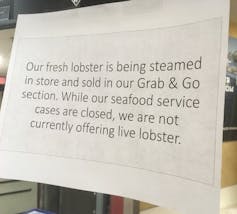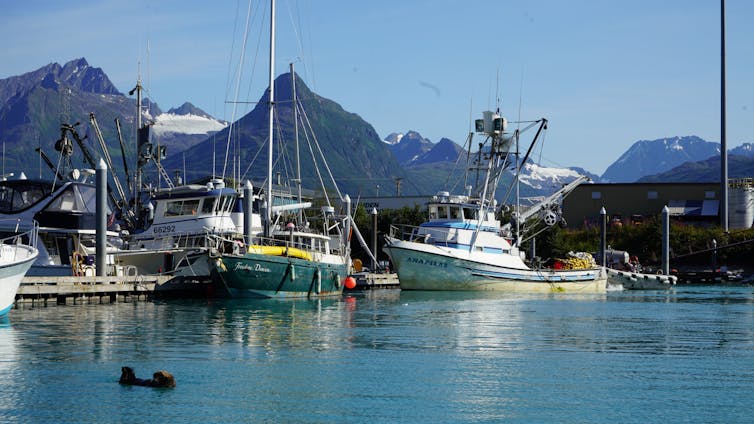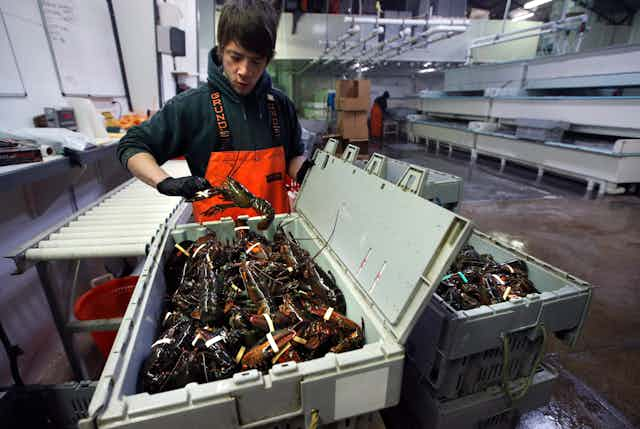COVID-19 is having a significant impact on North America’s seafood economy, which is more globalized than it has ever been. Fishers, however, are scrambling to respond, adapt and share lessons with each other. Community-supported fisheries may be the ones most ready to weather this difficult time.
Major commercial fisheries, including the iconic Maine lobster fisheries, have ground to a halt. The closure of restaurants and fresh seafood counters has created a serious dent in demand. Even temporarily, this is a serious blow to small-scale harvesters and fishing communities, who often derive most of their sales from these markets.

Consider the lucrative Pacific halibut fisheries, which opened in mid-March. These fisheries largely serve fine dining restaurants. Grilled halibut entrees fetch northward of $30 at iconic Vancouver restaurants such as Joe Fortes. But with restaurants closed, wholesale halibut prices are down a dollar or more from last year’s average of US$5.30 per pound and are expected to drop further.
Combined with the loss of sales to markets like China, seafood producers from east to west are without a market for their product.
A shifting market
At the same time, worried consumers are stocking up on the canned and frozen products that are still available. Others are hoping to connect directly with local fishers to fill emerging demand.
Many fishers are adapting to accommodate this tumultuous new market. Some who previously catered to restaurants are finding their inboxes overwhelmed by individuals wanting to buy their seafood direct.
But decades of globalization, industrialization and environmental change have brought many coastal communities to the brink, because of coastal development, climate change or they’ve lost fishing rights to industry consolidation. To meet this moment, many need more than just an invigorated customer base.
A better way to eat from the sea?
Direct marketing is a small but growing sector in the seafood industry. Community-supported fisheries, or CSFs, are locally operated and organized individuals or groups of fishers who have opted out of the mainstream ways of getting seafood into stores. Instead, they take over the entire supply chain: they catch it, clean it and, in many cases, distribute it right to your door.

Those who market their fish direct to consumers see a variety of benefits such as reduced operating costs and the ability to pay a premium wage to employees. Consumers, likewise, gain access to high quality food that is fished in a way that matches their social and environmental values.
CSFs also increase the resilience of our food system. They add diversity, shorten supply chains, and address the shortcomings of the “just enough, just in time” system COVID-19 has pushed to the limit.
Rebuilding coastal communities
Buying local is not a new refrain, neither is it a panacea for the problems facing coastal communities.
Many fisheries have been, or continue to be, overfished. Other fisheries have been closed or threatened for political rather than ecological reasons, such as commercial fisheries in Florida and Cook Inlet, Alaska.
In North America, several fisheries have consolidated because privatization has allowed fishing rights to migrate out of the hands of individuals and into the hands of a few large shareholders.
However, fishers are responding to this current crisis in a way that could have lasting change for the industry. In a March 31 webinar hosted by the Local Catch Network, a community of practice for small-scale fishers across Canada and the United States, more than 180 operators talked about their experiences with “pivoting on the fly.”
Some shared stories about how they’re now selling almost entirely direct to consumers. Others are thwarted by shelter-in-place restrictions that prevent them from being able to deliver fish to eager customers.

Still, new connections between fishermen, local fisheries and consumers are being made. And not just in North America. Fishers around the world are turning to local marketing as a response to COVID-19.
A question remains whether these new innovations will be met with the policy support to necessary to turn them into lasting change, or whether they will be forced back yet again when business as usual resumes.
Canada, for example, has implemented a portfolio of economic relief policies that fishers can tap into. But short-term relief rarely translates to long-term structural change.
It is difficult during this time of hardship to think about the future. Still, whenever the status quo is disrupted, there are invariably people who come out better for it because disruption creates new opportunities. Being resilient, bouncing back from harm, always comes at a cost, but resilience can also also be a platform for shaping a new trajectory into the future.
COVID-19 has already exposed holes in health care, the economy and land-based food systems. Perhaps the disruptive power of this pandemic, in combination with how seafood producers are adapting, will create space for a more resilient model for fisheries and community food systems to emerge.

